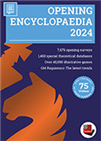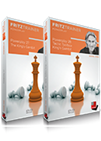Building blocks for your opening repertoire
Even as I write these lines, the Global Chess League Tournament has come to an end, with Triveni Continental Kings beating PBG Alaskan Knights in the Finals. As expected, there was fierce competition among all teams. One question of interest is, "How do these grandmasters play their openings?"
Now there is no dearth of information on opening theory in chess books, magazines and websites. However, one has to make a distinction between quality and quantity. In my view, the leaders in the field are ChessBase and ChessPublishing.com. ChessBase publishes a number of DVDs on individual openings and main variations. The flagship, ChessBase Magazine, offers a dozen opening surveys and three opening DVDs every two months. Its output goes directly into the Opening Encyclopaedia. This is helpful to a player as he cannot keep track of every opening system analysed in ChessBase Magazine year after year.
 The new ChessBase Opening Encyclopaedia 2024 - More content. More ideas.
The new ChessBase Opening Encyclopaedia 2024 - More content. More ideas.The current edition of Opening Encyclopaedia has as many as 1.463 opening articles, 75 videos, 7.679 surveys right up to March 2024. It has a database of 40,738 games played right till the end of 2023.
From May 2023 to March 2024, 66 new repertoire ideas and 50 new videos have been added to this edition.

What can the Encyclopaedia do for you? Essentially, it offers building blocks for your opening repertoire. You have to choose what suits your temperament and style. Thereafter, you have to see which lines have stood the test of time and which others are making a return.
Here let me offer a general guideline: opening surveys from 2021 to 2024 along with games offer a fair idea of recent practice. So do check out the variations. Use the older surveys and games for ideas. In some cases, lines have merely gone out of fashion, and they are still intrinsically sound. In other cases, lines have undeservedly fallen by the wayside on account of a resounding victory. So verify both ideas and variations. The engine is of course an ally, but use your own judgement at the end of the day.
It's said, "A week is a long time in politics". I would say, a month is a long time in chess. Soon after this Encyclopaedia appeared, the Candidates Tournament was played. The games enriched theory. In more than one opening. The variation, Jaenisch Gambit (C70), became famous on account of Praggnanandhaa's victory over Vidit Gujrathi in this event.

Vidit Gujrathi v. Praggnanandhaa Rameshbabu | Photo: FIDE/ Michal Walusza
In this edition of the Openings Encyclopaedia, you find Adrien Demuth's analysis of the opening. You have to supplement it with Petra Papp's analysis in CBM 221. Here we have room for the main game:
The Opening Encyclopaedia here covers almost all lines of the Spanish (C60-C96). Only some older lines of the Chigorin (C97-C99) are left out.
Last time I had dealt with some lines of the Closed Spanish. This time I shall deal with some important lines from the Open Spanish. For starters, let me take up the treatment of the Dilworth Variation by Robert Ris. This is fairly detailed, and we have room for one game, Carlsen-Mamedyarov, 2021. I have offered more explanation and updated analysis for readers not familiar with opening theory.
The lines shown in the variations are a testimony to the richness and complexity of the Dilworth variation.
There is another line similar to the Dilworth Variation. It is analysed by Tanmay Srinath.
He has also made a remarkable theoretical discovery in the Open Spanish.
King's Gambit
 Glorious sacrifices, unexpected tactics and checkmating attacks. The King's Gambit is one of the oldest and most romantic openings in the game of chess. These DVDs contain all you need to know to play the King's Gambit.
Glorious sacrifices, unexpected tactics and checkmating attacks. The King's Gambit is one of the oldest and most romantic openings in the game of chess. These DVDs contain all you need to know to play the King's Gambit.One section that needs to be updated is the work on the King's Gambit. ChessBase has produced a string of DVDs on the King's Gambit. The main analysis in these DVDs set is yet to be included in the Encyclopaedia here. How should players with Black deal with the King's Gambit? They can accept the gambit pawn and be prepared for a tactical slugfest.
In this context let me mention a rare bird in the King's Gambit: 1.e4 e5 2.f4 exf4 3. Nf3 Nf6. It is named after Emil Schallopp (1843-1919).

German chess master and author Emil Schallopp
Aficionados of the King's Gambit should check out Krisztian Szabo's analysis of the Defence in this Encyclopaedia.
Readers would also find another line here: 1.e4 e5 2.f4 exf4 3. Nf3 Ne7. However, I am sceptical about this line. The knight blocks the path of the dark-squared bishop and is also unable to fight for the control over the centre.
If you are Black, you also have to cope with lines branching with 3.Bc4 or 3.Nc3, very dangerous lines. You can avoid all of it with the Falkbeer-Nimzowitsch Counter Gambit. Currently, it is out of fashion and not included in this Encyclopaedia. I believe, it deserves to be tested. Here is a sample of the variation:
Is the King's Gambit playable in 2024? Yes. There is nothing like it for sheer romance and adventure in chess. It is also a surprise weapon in rapid and blitz tournaments. However, you have to be thorough in your preparation.
I am sympathetic to both the Latvian Gambit and the Elephant Gambit. As of now, both are under rough weather. However, the analysis here by Peter Leisebein and Alexander Bangiev is of archival value.
In the second part of this review, I shall deal with the treatment of semi-open games in this Encyclopaedia. Watch this space.
Links
Further Reading
- How to Open a Chess Game (RHM Press 1974)
- Chess Opening Essentials Vol. 1 - The Complete 1.e4 (New in Chess 2007)
- Mastering the Chess Openings (Vols. 1, 2, 3, 4) by John Watson (Gambit Publications 2006-2010)
- The Ruy Lopez: A Guide for Black by Sverre Johnsen and Leif Johanessen (Gambit Publications 2007)
- The Ruy Lopez Revisited by Ivan Sokolov (New in Chess. 2009)
- The Chigorin Bible: A Classic Defence to the Ruy Lopez by Ivan Sokolov and Ivan Salgado Lopez (Thinkers Publishing 2018)
- The Zaitsev System by Alexey Kuzmin (New in Chess 2016)
- The King's Gambit by John Shaw (Quality Chess 2013)
The new ChessBase Opening Encyclopaedia 2024 - More content. More ideas.


























